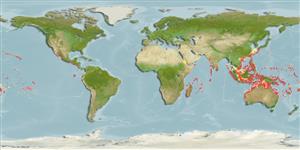Classification / Names
Common names from other countries
Main reference
Size / Weight / Age
Max length : 45.0 cm TL male/unsexed; (Ref. 90102)
Environment
Marine; reef-associated; depth range 0 - 70 m (Ref. 89972), usually ? - 20 m (Ref. 9269)
Climate / Range
Tropical, preferred ?; 32°N - 32°S
Distribution
Indo-Pacific and Eastern Pacific: Red Sea and South Africa (Ref. 4113) to Panama, north to southern Japan and the Hawaiian Islands, south to the Lord Howe and the Society islands. Referred to as Antennarius moluccensis by authors.
Countries | FAO areas | Ecosystems | Occurrences | Introductions
Short description
Dorsal
spines
(total): 3;
Dorsal
soft rays
(total): 12-13;
Anal
spines: 0;
Anal
soft rays: 8. Comes in a variety of colors: yellow, orange, green, brown, and black. Bony part of illicium about equal to length of the 2nd dorsal spine (10.2-16.9 %SL); esca a small tuft of flattened appendages (Ref. 4538). Illicial length in %SL: 19.3-25.2 (Ref. 6773). Membrane behind 2nd dorsal spine thick and spinulose, extending to base of third (Ref. 6773). One of the largest species (Ref. 48635).
IUCN Red List Status (Ref. 115185)
Threat to humans
Harmless
Human uses
Fisheries: of no interest
More information
ReferencesAquacultureAquaculture profileStrainsGeneticsAllele frequenciesHeritabilityDiseasesProcessingMass conversion
Tools
Special reports
Download XML
Internet sources
Estimates of some properties based on models
Phylogenetic diversity index
PD50 = 0.5005 many relatives (e.g. carps) 0.5 - 2.0 few relatives (e.g. lungfishes)
Trophic Level
4.2 ±0.73 se; Based on food items.
Resilience
High, minimum population doubling time less than 15 months (Fec assumed to be > 10,000)
Vulnerability
Low vulnerability (23 of 100)
Price category
